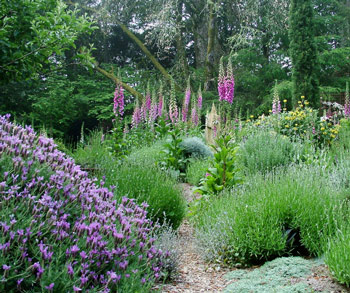Is Drip Irrigation for You?

I just completed a major revision of my classic book on drip irrigation. Here’s an excerpt taken from the beginning. Thoughts to consider when planning next year’s garden. (The photo shows a garden with no drip parts showing--the whole point. Drip can be done without any ugly parts in view.)
Somewhere out there, perhaps, is a garden that wouldn’t benefit from drip irrigation. In this garden, the rains come with absolute regularity, just when the soil is beginning to dry, and never too far apart. For real gardens, however, watering between irregular rains or during protracted droughts is a fact of life.
Although drip systems are initially somewhat more complicated than dragging a hose around with an attached oscillating sprinkler, the benefits from drip irrigation, in any climate, far outweigh the hassles.
Is Drip Irrigation for You?
Drip irrigation isn’t for everybody or every situation. No technology or tool is appropriate for universal application, and like any gardening tool, drip irrigation has various benefits and certain limitations. Before you decide to design and install your own system, consider the following pros and cons of drip irrigation. In reading through them, you may find that the drawbacks outweigh the advantages for your garden, in which case an extensive drip system probably isn’t for you. Most gardeners, however, will find that drip irrigation may be appropriate for a portion, if not all, of their ornamental plantings and at least some of their edible crops.
The Benefits of Drip Irrigation
The advantages of drip irrigation can be summarized as follows:
• Uses water efficiently. Sprinklers waste a lot of water as a result of wind-scattered spray, sun-powered evaporation, runoff, the evaporation of accumulated puddles, or deep leaching. Various studies have documented a savings—when compared to furrow irrigation—of 30% to 70%, depending on the crop, climate, and use of mulch [or no mulch].
• Provides precise water control. Every part of a drip irrigation system can be constructed with an exact flow rate. It is very easy to calculate what the total flow of the system amounts to and to match this with the plants’ needs. You’ll know exactly how much water you’re applying and will be able to control the amount down to the ounce.
• Increases yields. Drip irrigation can be used for the slow, gradual application of tiny amounts of water on a frequent, or daily, basis. This maintains an ideal soil moisture level, promoting more abundant foliage, greater bloom, and higher yields (by actual comparison) of produce, fruits, and nuts than those produced by any other approach to irrigation.
Research in many different climates and states invariably supports the benefits and cost-effectiveness of drip irrigation. Art Gaus, an extension horticulture specialist with the University of Missouri at Columbia, MO, has had a drip system in his personal garden for nine years. One summer, his bush watermelons with plastic mulch and a drip system produced 32 pounds in four-by-four-foot, compared with 9–16 pounds in an area with conventional irrigation. He reckons a well-timed drip system “could mean a 100% increase in yields; during the droughts of 1980, ’83, and ’84, it meant the difference between having a crop or no crop at all.”
In a study of established pecan trees in Georgia, trees with drip irrigation had a 51% increase in yields.
Michigan State University has documented a 30% yield increase in vegetable crops with drip irrigation, even in its humid, summer-rain climate.
A study in India in 2002 found that with chilies water use was down 34-50%, while production was up 33-48%. The researchers attributed this to irrigation that kept the soil moist, not too dry.
A study in New Mexico found amazing differences in yields compared to [respectively] furrow and drip irrigation: 18 pounds versus 30 pounds with cucumbers, 69 to 156 pounds, growing Swiss chard, and 64 versus 166 pounds with green beans—to quote a bit of the study. [It is interesting to note that broccoli, Brussel sprouts, and carrots didn’t have any greater yields in the drip irrigation plots. Yet, a study at Oregon State University found a 20% increase in carrots compared to plots with sprinklers.]
• Provides better control of saline water. Sprinklers apply water to the foliage; if your water is saline, this can cause leaf burn. Drip irrigation applies water only to the soil, and frequent applications with drip irrigation help to keep the salts in solution so they don’t affect the roots adversely. [Any salt crust buildup at the margins of the moist area can be leached away with an occasional deep irrigation.]
• Improves fertilization. With a device called a fertilizer injector (or proportioner), you can easily apply dissolved or liquid fertilizers with accuracy and without leaching the fertilizer beyond desired root zones. The liquid fertilizers can be applied with each irrigation or only when required.
• Encourages fewer weeds in dry-summer climates. The small moist spot around each emitter, where the water slowly dribbles out, covers only a fraction of the soil’s surface. The larger dry areas between emitters remain too dry for weed seeds to sprout.
[Note: This benefit is lost in areas with summer rains.]
|
|
• Saves time and labor. Drip irrigation systems eliminate tedious and inefficient hand watering. Automatic drip systems add the convenience of not even having to remember to turn valves on and off by hand. (The initial installation of such a system, however, will take more time and effort than all other forms of irrigation except permanent sprinkler systems.)
• Eliminates soothing hand watering. For some gardeners, the act of standing out in the garden near sunset and watching the moon rise, listening to the mockingbird warble, and rhythmically swaying back and forth with a hand-held sprinkler is more valuable than any form of therapy or meditation. For these people, drip irrigation may be counterproductive.
• Reduces disease problems. Without the mist produced by a sprinkler, drip-irrigated plants are less likely to develop water-stimulated diseases such as powdery mildew, leaf spot, anthracnose, shothole fungus, fireblight, and scab. Furthermore, careful placement of emitters away from the trunks of trees, shrubs, perennials, and vegetables will keep the crown of the root system dry and minimize such root problems as crown rot, root rot, collar rot, and armillaria root rot.
• Provides better water distribution on slopes. Sprinklers often create wasteful runoff when set to water the upper slopes of hills or berms. Drip emitters can apply the water slowly enough to allow all the moisture to soak into the soil. Some emitters, known as pressure-compensating emitters, are designed to regulate the water flow so that all emitters in the system put out the same gentle flow, regardless of slope.
• Promotes better soil structure. Heavy sprinkler irrigation can produce puddles, causing clay particles to stick together, and increase soil compaction. Drip-applied water gradually soaks into the ground and maintains a healthy aerobic soil which retains its loamy structure.
• Conserves energy. Because of the low-pressure requirements of a drip irrigation system, the pumping costs, whether from municipal water supplies or from your own well, are lower.
• Uses low flow rates. The low-volume application rate of drip emitters permits larger areas to be watered at the same time than is possible with sprinkler systems.
• Is more economical than permanent sprinkler systems. While more costly than a hose with an oscillating or hand-held sprinkler, drip irrigation systems usually cost less than fixed sprinkler systems.
The Limitations of Drip Irrigation
Some drawbacks of drip irrigation include the following:
• Initial costs are high. A garden hose with a simple oscillating sprinkler will always be cheaper than drip irrigation, but it doesn’t offer the same measure of control and water conservation. A well-designed drip system will more than repay the cost of installation in reduced effort, fewer irrigation chores, and greater yields.
• Can clog. This is really a limitation of older and outdated emitters. Many early models of emitters were more prone to clogging and gave the industry a bad reputation. All this has changed; with adequate filtration, the emitters featured in this book have performed successfully with city water, well water, and water with dissolved iron and calcium. Some types, such as the noncompensating in-line emitter tubing, even function reliably with filtered gray water systems.
• May restrict root development. Early and out-moded designs for drip systems called for only one or two emitters per plant. This led to very restricted root growth around the few points of moisture and thus to stunted plant growth. One major goal of this book is to show how the emitters should be placed to cover the entire area of natural root growth. With the proper placement of emitters, root growth will be uniform, expansive, and healthy.
• Rodents can eat the tubing. There are a number of drip irrigation systems that can be buried in the soil, but if your garden has gophers, you’ll just be offering them an easier way to drink. Occasionally, even mice and wood rats will hear the running water in the drip hose, especially in dry summer climates, and chew through for a swig of aqueous delecti.
• Isn’t compatible with green manure and cover crops. The growth of a green manure crop gets all tangled up with the drip tubing, thus prohibiting the usual “tilling under” of the plants. Cover crops are usually grazed or mown, both of which would damage a surface drip system. And both buried and surface drip systems would leave too much of the surface dry for adequate germination of cover crop or green manure seeds.
• Weeding can be difficult. Unmulched drip irrigation systems will stimulate some weeds around each emitter, and care must be taken not to damage the drip system while weeding. A protective and attractive layer of mulch will greatly reduce, if not eliminate, this problem.
• Requires greater maintenance. Very little can go wrong with your typical hose-and-oscillating-sprinkler setup. Drip irrigation requires more routine maintenance to sustain its high level of efficiency, but such maintenance is relatively simple.
• Doesn’t cleanse the foliage. In arid climates, some plants, such as lettuce and other leafy greens, prefer periodic sprinkling of leaves to wash off accumulated dust, grit, and/or air pollution. These plants need to receive an occasional sprinkling or be grown with low-flow sprinklers.
• Doesn’t create humidity. Many plants, most notably humidity-loving perennials from England, the muggy Tropics, and northern Europe, like a moist atmosphere. When these plants are grown outside their natural environment, sprinklers and misters are perhaps the better irrigation devices. (For many other plants, a drip system’s lack of additional humidity is a bonus, inhibiting fungal and bacterial diseases.)
• You can’t see the system working. With a well-mulched drip system, the emitters quietly go about their work hidden from view. For some gardeners, this is the beauty of the system. For others, not being able to watch the watering is slightly unsettling. In a poorly designed system, a clogged emitter goes unnoticed until drought stress affects the plant visibly. This is a serious problem only with poor quality emitters and the old-fashioned concept of placing only one or two emitters next to each plant. The design approach in this book protects the plants from any stress as a result of clogging.
|

